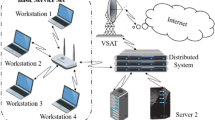Abstract
The rapid development of wireless in-building communication systems, has widened the scope of supported applications. Remote terminals may be capable of producing broadband real-time traffic such as variable bit-rate (VBR) video or bursty data transfers. Consequently one of the important issues in indoor broadband wireless networks (IBWN) is employment of an efficient bandwidth management protocol. In such a protocol, both the effects of radio channel behavior and the traffic heterogeneity have to be considered. In this paper we present a bandwidth allocation scheme based on the interplay of the radio channel characteristics and the traffic parameters and requirements. In the proposed scheme the base station visits the terminals in a non-uniform cyclic fashion. The inter-visit interval and the amount of service which is provided to each user during a visit, is determined using the channel and traffic parameters based on an analytical approach. This system is evaluated by simulations and is found to provide improved performance in fulfilling the requirements of multimedia services in IBWN.
Similar content being viewed by others
References
D.D. Falconer, “A system architecture for broadband millimeter-wave access to an ATM LAN”, in Wireless 95, Calgary, Alberta, July 1995.
A.A.M. Saleh and L.J. Cimini, Jr., “Indoor radio communications using time-division multiple access with cyclical slow frequency hopping and coding”, in ICC '88, Vol. 2, pp. 774–780, 1988.
H. Takagi, “Queueing analysis of polling models: An update”, in Stochastic Analysis of Computer and Communication Systems, H. Takagi (ed.). Elsevier Science Publishers B.V. (North-Holland), pp. 267–318, 1990.
N. Movahhedinia, G. Stamatelos and H.M. Hafez, “A slot assignment protocol for indoor wireless ATM networks using the channel characteristics and the traffic parameters”, in GLOBECOM '95, pp. 327–331, 1995.
Li San-Qi and H.D. Sheng, “Discrete queueing analysis of multimedia traffic with diversity of correlation and burstiness properties”, IEEE Trans. on Communications, Vol. 42, Nos. 2–4, pp. 1339–1357, 1994.
S. Kowtha and D.R. Vaman, “A generalized ATM traffic model and its application in bandwidth allocation”, in ICC '92, Vol. 2, pp. 1009–1013, 1992.
Z. Zhang and A.S. Acampora, “Performance of a modified polling strategy for broadband wireless LANs in a harsh fading environment”, in Telecommunication Systems, Vol. 1, No. 3, pp. 279–294, 1993.
J.P. Linnartz, Narrowband Land-Mobile Radio Networks. Artech House, 1993.
D. Bertsekas and R. Gallager, Data Networks. Prentice-Hall: Englewood Cliffs, New Jersey, 1987.
Author information
Authors and Affiliations
Rights and permissions
About this article
Cite this article
Movahhedinia, N., Stamatelos, G. & Hafez, R. A Time-Slot Assignment Strategy for ATM Broadband Indoor Wireless Networks. Wireless Personal Communications 5, 89–111 (1997). https://doi.org/10.1023/A:1008817827344
Issue Date:
DOI: https://doi.org/10.1023/A:1008817827344




